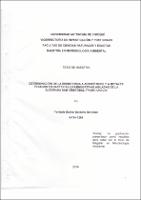Mostrar el registro sencillo del ítem
Determinación de la resistencia a antibióticos y a metales pesados en bacterias gramnegativas aisladas de la quebrada San Cristóbal-tramo UNACHI.
| dc.contributor.author | Saldaña Sánchez, Yorlenis Esther | |
| dc.date.accessioned | 2022-05-17T16:23:20Z | |
| dc.date.available | 2022-05-17T16:23:20Z | |
| dc.date.issued | 2018 | |
| dc.identifier.uri | http://jadimike.unachi.ac.pa/handle/123456789/334 | |
| dc.description.abstract | Resistance to antibiotics and heavy metals was determined in gram-negative bacteria isolated from the San Cristobal ravine UNACHl stretch. For the isolation of microorganisms was used Tioglicolato Broth. Blood Agar and Macconkey Agar was used and the resistance test the automated system Vitek®2 was used. The antibiotics used were cefotaxime, ampicillin, ciprofloxacin, gentamicin and imipenem. In the test of resistance and susceptibility the system Vietk®2 was used by means of the cards GN AST N249 for gram-negative bacilli. A totalof 41 microbialisolates from eleven different species of gram-negative bacteria of the genera Pseudomonas, Klebsiella, Escherichia, Enterobacter, Citrobacter, acinetobacter, Providence and Proteus were. The highest percentages of resistant strains were with respect to cefotaxime and ampicillin. Of the microbial isolates the species of Pseudomonas aeruginosa and Escherichia coli, showed greater resistance to cefotaxime and ampicillin. Minimum concentrations of heavy metals were used such as lead acetate (II). arsenic oxide (III), mercury chloride (II), chromium (IV) oxide and cadmium chloride and the effects of these were evaluated in MOeller Hinton agar about its growth. The microorganisms identified showed greater resistance to arsenic and lead. The bacteria of the genus emterpbacter showed greater resistance to arsenic and the species of Klebsiella pneumoniae showed greater resistance to lead. The presence of bacteria resistant to antibiotics poses a risk to humans and the environment. The resistance of bacteria to heavy metals confirms their relationship with the presence of antibiotic resistant microorganisms when the genes responsible for this resistance are found in the same plasmid. | |
| dc.description.abstract | Se determinó la resistencia a antibióticos y a metales pesados en bacterias gramnegativas aisladas de la quebrada San Cristóbaltramo UNACHI. Para el aislamiento de microrganismos se utilizó Caldo Tioglicolato, Agar Sangre y Agar Macconkey, y para la prueba de resistencia se utilizó el sistema automatizado Vitek®2. Los antibióticos utilizados fueron cefotaxima. ampicilina, ciprofloxacina, gentamicina e imipenem. En la prueba de resistencia y susceptibilidad se empleó el sistema Vietk®2 mediante las tarjetas GN AST N249 para bacilos gramnegativos. Se obtuvo un totalde 41 aislados microbianos de once especies diferentes de bacterias gramnegativas de los géneros Pseudomonas, Klebsiella, Escherichia, Enterobacter, Citrobacter, Acinetobacter, Providencia y Proteus. Los mayores porcentajes de cepas resistentes fueron con respecto a cefotaxima y ampicilina. De los aislados microbianos las especie de Pseudomonas aeruginosa y Escherichia coli, mostraron mayor resistencia a cefotaxima y ampicilina. Se utilizaron concentraciones mínimas de metales pesados como Acetato de plomo (II), Óxido de arsénico (III), Cloruro de mercurio (II). Óxido de cromo (IV) y Cloruro de cadmio y se evaluó en agar Müller Hinton los efectos de éstos sobre su crecimiento. Los microorganismos identificados mostraron mayores resistencias al arsénico y al plomo. Las bacterias del género Enterobacter mostraron mayor resistencia al arsénico y las especies de Klebsiella pneumoniae mostraron mayor resistencia al plomo. La presencia de bacterias resistentes a antibióticos representa un riesgo para los seres humanos y el ambiente. La resistencia de las bacterias a metales pesados, confirma su relación con la presencia de microorganismos resistentes a antibióticos cuando los genes responsables de esta resistencia se encuentran en el mismo plásmido. | |
| dc.language.iso | es | es_ES |
| dc.publisher | Universidad Autónoma de Chiriquí. | es_ES |
| dc.subject | BACTERIAS GRAMNEGRATIVAS. | |
| dc.subject | ANTIBIOTICOS | |
| dc.subject | NC - QUEBRADA SAN CRISTOBAL | |
| dc.subject | TESIS - MAESTRÍA MICROBIOLOGÍA AMBIENTAL | |
| dc.subject | ||
| dc.title | Determinación de la resistencia a antibióticos y a metales pesados en bacterias gramnegativas aisladas de la quebrada San Cristóbal-tramo UNACHI. | es_ES |
| dc.type | Thesis | es_ES |
Ficheros en el ítem
Este ítem aparece en la(s) siguiente(s) colección(ones)
-
Maestría en Biología [33]

